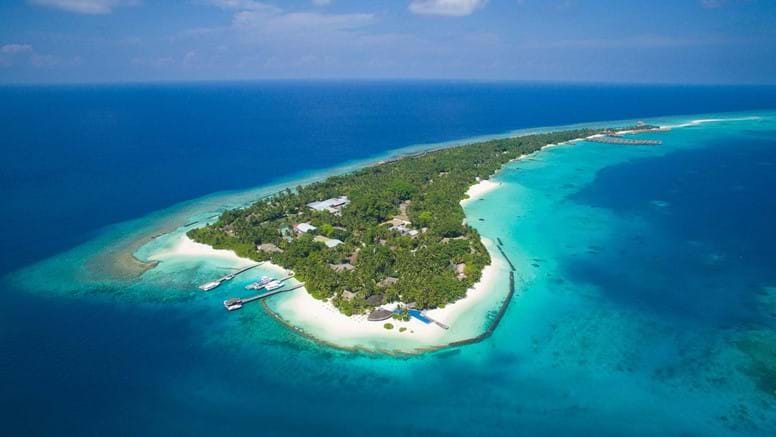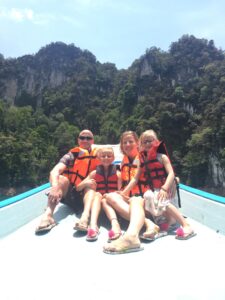This guest blog was written by Tima Batstone, a Maldivian who, since getting married, is living in Barcelona. Whenever possible, Tima loves going home.
The islands of the Maldives are legendary for their perfection, with their talcum white sands and Instagram worthy shades of blue. Yet amongst these island fantasies, here is one that stands out: Kuramathi .
Kuramathi has been a home from home to our family for many years. Positioned in the Ari Atoll (atoll is the Maldives’ contribution to the Oxford Dictionary of English), just over an hour’s ride by speedboat, from Male International Airport, today’s Kuramathi is one of the largest resorts in the Maldives. Unlike many of the other resorts, Kuramathi is blessed with an abundance of vegetation: the ancient banyan tree that stands at the heart of the island is not part of the landscaping. Dense jungle has long covered the centre of this long thin island :you can circle it in around 25 minutes; other islands take 10 to cover. This sense of natural history gives the island a unique feel.
Many years ago my family had the most wonderful all day picnics on the then uninhabited Kuramathi. We have so many happy memories of entire days spent playing, swimming and even eating in the sea, playing hide and seek amongst the trees, long siestas and tea in tents, leaving the island just before dusk, the jungle in the middle suddenly appearing rather forbidding. Kuramathi is right next to the Rasdhu, an inhabited island where the Atoll Administration is based, a place where guest houses proliferate today. We would stay over at the Atoll Chief’s island which seemed the height of luxury at the time.
Today, Kuramathi Resort is up there with the best of the mid-market resorts (it is luxurious without the label) and has a cult following of repeat visitors, including our family, drawn by its irresistible sense of peace and charming service. There are 3 resort areas on the island, each with its own main restaurant and pool and a wide variety of other dining and lunch options including Indian, Thai, sushi, hotpot and grill. The rooms have been refurbished and are water bungalows abound with all the mod cons. The spa has retained its Balinese style zen, helped by the frangipani trees that surround the open air jacuzzi, the flowers floating everywhere.
Kuramathi may have joined the modern age of upmarket tourism that is the Maldives tourism hallmark, but it retains its rustic charm and its size means it can accommodate both families and honeymooners. There is a very well-run kids’ club in the centre of the island with an imaginative range of activities for the younger ones that makes the most of the lush environment. The part of the resort nearest the island’s picturesque sandbank, (“Thundi” in Divehi, the local tongue) has a more quiet, exclusive feel, although the nearby poolside champagne bar is a favourite for those seeking a sundowner. The Sand Bar on the other end of the island is our night time favourite: you can lie on beanbags in the sand, stargaze and feel lost in the universe as the stars rain down on you. Pure heaven, little night pollution. The list of sensations is long but you have to go there really, to experience the hidden corners of the island. It is all about exploring its long held secrets.
In terms of service it is exceptional. The island is run like clockwork with a high staff to guest ratio. Staff have their own leisure quarters and hold their own sports tournaments. There is a feeling of community, built over years of being together. The island has an excellent medical centre and is one of the few resorts with a decompression chamber. The water sports is another area that has been fully modernized and offers a wide variety from diving to SUP and the range grows every year.








